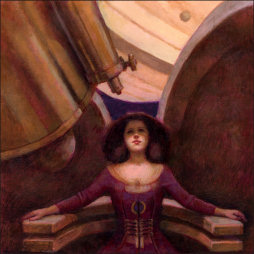Home
Gallery
Prints
Articles
About
Contact
CHRIS BENNETT
Artist
Articles

FORBIDDEN PLANET - A touch of the sublime
Although I consider the film ‘Forbidden
Planet’ to be a beautiful
piece of work in itself, there is a scene very early on which
introduces Robbie the Robot which is a clue as to why. But it is
only a clue, since the very nature of sublime is that it always
just
eludes analysis.
It is the scene where we first see the main door of the spaceship
open and the descent of the crew onto the surface of Altair 4.
But instead of alien monsters emerging, we see human beings
walking confidently down the steps, at ease with a technology
that has brought them to this world faster than the speed of
light. The sense of scale and alien environment is achieved in a
way which is peculiar to the time the film was made, and it is in
this faintly melancholic scene that we notice a trail of dust in
the distance indicating something travelling extremely fast. We
are unsettled, and expect what arrives in the next shot to explain
the situation. At first it seems to: it is a robot. What’s more, it
is
benign and candid; we are even able to witness its internal
workings visible through its transparent casing (we can ‘see the
washing going around’ as it were; a fitting analogy since its
designer spent his early career designing washing machines).
Yet for all this and the explanations it provides, we seem to be in
the presence of an even deeper mystery as this wonderful
machine stands before them on the sands of Altair 4. We are
shown the arrival of humanity as ‘masters’ of nature, yet within
a few moments we are presented with an enigma in the form
of Robbie; an ‘echo’ of themselves and their technology
represented as a mechanical man.
What makes these moments work and even touch what I
would call ‘sublime’ is largely the inspired efforts of the design
team. There is a unity to the visualisation that ties the ‘look’ of
Robbie to the men and their technology. It is as if the spaceship
and crew, which are the perfect product of the ‘50s optimism
and thereby its secular beliefs, is somehow condensed into the
image of Robbie the Robot; assured, courteous, powerful,
reasonable and confident; civilised.
Yet, and here’s the sublime bit: this shining man is utterly
enigmatic. We look at ourselves, just as we can look into
Robbie’s transparent ‘face’ and see the inner workings, but
what do we really understand?
Chris Bennett 2008